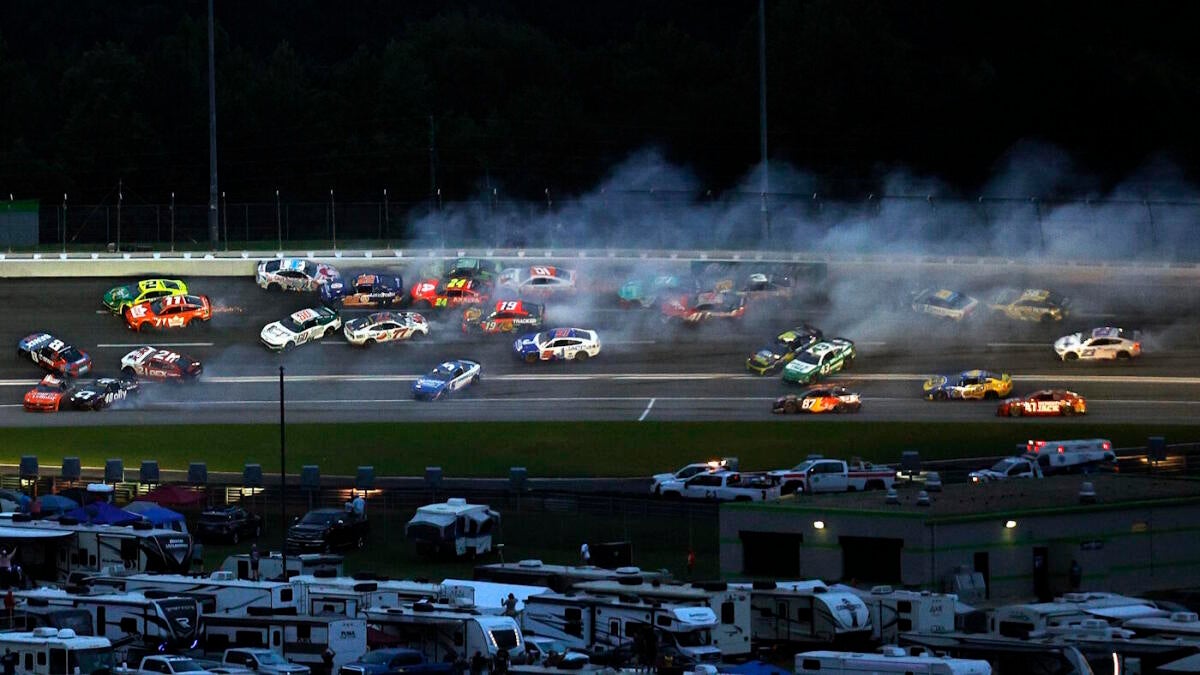The 2025 NASCAR Cup Series season has been a rollercoaster of high-speed drama, marked by some of the most catastrophic crashes in recent memory. The massive multi-car wrecks at EchoPark Speedway in Atlanta and Talladega Superspeedway have not only reshaped race outcomes but also sparked conversations about safety, strategy, and the very nature of stock car racing. These incidents serve as stark reminders of the delicate balance between speed and survival that defines NASCAR.
The EchoPark Speedway Crash: A Night of Chaos in Atlanta
The NASCAR Quaker State 400 at EchoPark Speedway in Atlanta became an instant talking point when a colossal crash unfolded early in Stage 2, involving over 20 cars. The wreck stemmed from a sequence of events that began with an earlier multicar incident at the end of Stage 1, which included prominent drivers like Christopher Bell and Ryan Blaney. As Stage 2 commenced on lap 69, tensions and proximity on the track culminated in a massive pileup that virtually decimated half the field.
Key figures, including Chase Elliott, Brad Keselowski, and Corey LaJoie, were caught in the turmoil around lap 150, during the late stages of the race. Drivers reported their cars were bent or broken, forcing some to retire from the race entirely due to irreparable damage. NASCAR was forced to call a red flag stoppage, highlighting the severity and scale of the wreck. LaJoie’s description of the crash as “damn bumper cars at Frankie’s Fun Park” underscored the chaotic and jarring nature of the incident.
This crash not only shaped the outcome of the Atlanta race but also underscored the risks drivers face and the unpredictable circumstances that superspeedway racing can bring. Although the series has seen similar large incidents, this one ranked among the most substantial in terms of the number of cars involved and the level of damage.
Talladega Superspeedway: The Largest Crash in NASCAR Cup Series History
Earlier in the 2025 season, Talladega Superspeedway made headlines with what has been described as the largest crash ever recorded in the NASCAR Cup Series. Approximately 28 cars were involved, nearly the entire field, in a single catastrophic event that halted the race and dramatically shuffled the competitive order.
Known colloquially as “The Big One,” superspeedway racing at Talladega is notorious for high-speed pack racing that increases the likelihood of massive multi-car wrecks. This particular crash was triggered by a minor collision that escalated quickly, unfolding into a spectacular pileup that left almost every car entangled and out of contention.
The fallout from this wreck had far-reaching consequences beyond just the day’s race results. Several contenders found their chances for championship points severely diminished, and the impact was keenly felt among both the drivers and their teams. Discussions circulated about potential changes to race management practices, such as cleanup handling and the possibility of allowing drivers to remain in their cars during wrecks to mitigate risks.
The Broader Impact of Large Crashes in NASCAR
These massive collisions at Atlanta and Talladega reveal deep truths about the nature of NASCAR racing in 2025. Despite technological advances in safety and engineering, the sheer number of competitors on track and the high-speed, close-proximity nature of the sport ensures that multi-car wrecks remain a defining and dramatic element of race weekends.
From a strategic perspective, such crashes force teams and drivers to reconsider approaches to racing, balancing aggression with caution, especially in critical championship rounds like the NASCAR In-Season Challenge or the Round of 12 playoffs. The 2025 season’s multiple large wrecks have amplified scrutiny on race strategy, chassis setup, and driver communications, as even a slight miscalculation or mechanical issue can trigger a race-ending catastrophe for many.
Additionally, these crashes heighten the emotional intensity for fans and participants alike. The wrecks shape narratives—stories of survival, missed opportunities, and unexpected twists—captivating audiences and fueling discussions on forums, social media, and broadcasts.
A Season Defined by Spectacle and Danger
What stands out about the crashes at the 2025 Atlanta and Talladega races is not just their scale but their timing in the season and impact on competition. While the spectacle draws viewers, it also serves as a harsh reminder of the delicate balance between speed and safety inherent in NASCAR racing.
As the season progresses, the memory of these massive wrecks will likely influence driver tactics and NASCAR’s regulatory decisions. Teams may push harder to fortify their cars’ durability and reconsider risk-taking during densely packed segments of races. Conversely, these incidents might drive innovations in safety gear and emergency response to reduce risks in future multi-car collisions.
The High Stakes and High Drama of NASCAR Crashes
The colossal crashes involving over 20 cars at EchoPark Speedway and an unprecedented 28-car pileup at Talladega have become defining moments of the 2025 NASCAR Cup Series. Far from isolated incidents, they exemplify the intense competitiveness, razor-thin margins, and ever-present danger at the heart of professional stock car racing.
These massive wrecks highlight the sport’s relentless thrill and unpredictability, contributing to a season rife with dramatic turns and unexpected outcomes. They challenge drivers, crews, and officials alike to continuously evolve safety protocols, race strategies, and engineering solutions—all while delivering the high-octane racing spectacle that fans crave.
In understanding these crashes, one gains a deeper appreciation for NASCAR’s blend of speed, skill, and survival instinct, where every lap can bring glory or disaster in a heartbeat. The 2025 season will be remembered not just for its winners but for the moments that tested the limits of human and mechanical endurance, reinforcing NASCAR’s status as one of the most exhilarating and perilous sports in the world.












